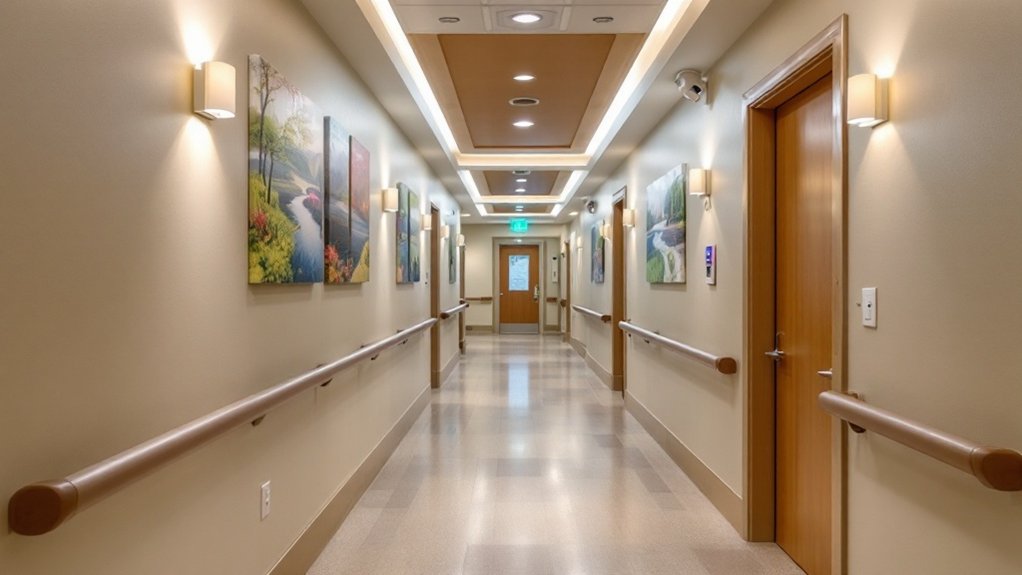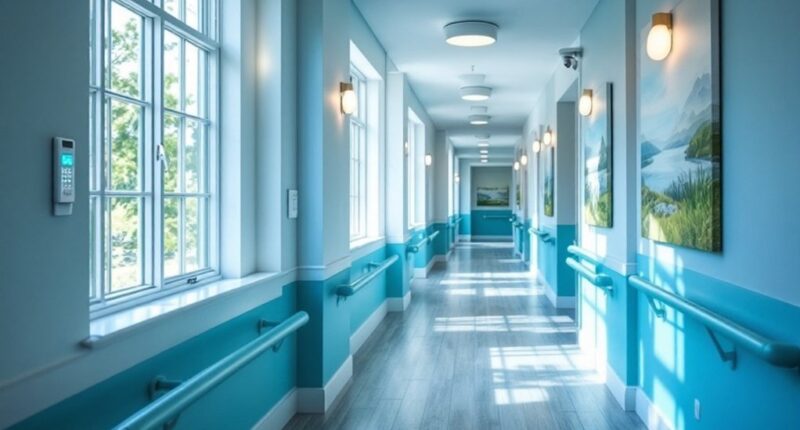When selecting a memory care facility for your loved one, prioritize seven critical safety features: secured entrances with electronic access control, wander guard technology for movement tracking, automated medication management systems, dementia-friendly infrastructure with non-slip floors and clear wayfinding, 24/7 trained staff presence, thorough emergency response protocols, and round-the-clock monitoring through security cameras. Understanding these essential components will reveal how top facilities implement multiple layers of protection while maintaining resident dignity and independence.

While the evolution of memory care facilities has prioritized thorough safety protocols, modern facilities now integrate multilayered security systems that combine physical infrastructure, technology, and specialized staff training to protect residents with cognitive impairments.
Electronic access control systems, featuring secured entrances with keypads and motion sensors, work in conjunction with wander guard technology to prevent unauthorized exits while maintaining detailed logging of resident movements throughout the facility.
Modern memory care facilities employ sophisticated access control and monitoring systems to protect residents while tracking their movements with precision.
The implementation of extensive technological solutions encompasses both preventative and responsive measures, with security cameras providing 24/7 monitoring capabilities while personal emergency response systems enable immediate staff intervention.
Automated medication dispensers with built-in verification protocols greatly reduce medication errors, while electronic health records facilitate real-time documentation and care plan modifications based on resident needs and behavioral patterns. Unlike standard nursing home care, memory care facilities offer specialized medication management systems specifically designed for residents with cognitive decline.
Physical infrastructure modifications incorporate evidence-based dementia-friendly design elements, including non-institutional layouts that reduce confusion while maintaining security. Calming art displays create tranquil environments that help reduce resident anxiety and agitation.
Wide corridors with non-slip flooring, strategically placed grab bars, and enhanced lighting systems with automatic sensors collectively minimize fall risks, while simplified wayfinding systems utilizing color-coding and clear signage optimize resident navigation capabilities.
Round-the-clock staffing protocols guarantee continuous monitoring and rapid response to emergencies, with personnel receiving specialized training in dementia care, crisis de-escalation, and validation therapy techniques.
These extensive training programs enable staff to effectively manage behavioral challenges while maintaining resident dignity and autonomy within a secure environment. Dedicated staff members establish meaningful connections with residents through individualized care plans to enhance safety outcomes and emotional well-being.
The integration of structured daily routines with consistent scheduling of meals, activities, and cognitive stimulation programs provides essential temporal orientation for residents while supporting their physical and mental well-being.
Emergency response protocols incorporate multiple redundant systems, including automated shut-off features for appliances, detailed fire safety equipment, and clearly defined evacuation procedures, guaranteeing rapid and coordinated responses to potential crises while maintaining resident safety as the paramount concern.
Frequently Asked Questions
How Much Does Memory Care Typically Cost per Month?
You'll find memory care costs vary considerably across the U.S., with 2023 national averages reaching $8,399 per month, though rates range from $3,500 to over $10,000.
Your location heavily influences pricing, with urban areas and states like Hawaii commanding premium rates exceeding $10,000, while rural regions and states like South Dakota offer more affordable options around $3,000-$4,000 monthly.
Your total cost will depend on facility type, room selection, and required care level.
Can Residents Bring Their Own Furniture to Memory Care Facilities?
While you can generally bring approved personal furniture to memory care facilities, you'll need to verify specific policies as they vary by location.
Most facilities permit essential items like dressers, chairs, and small tables that fit within the typical 12' x 12' or 14' square room dimensions.
You'll need prior approval, and items must meet safety requirements, including non-slip features and appropriate weight restrictions.
What Level of Medical Training Do Memory Care Staff Members Have?
Memory care staff must meet state-mandated training requirements, typically including 6-12 hours of initial dementia-specific education within six months of hire.
You'll find that certified staff complete annual refresher courses of at least three hours, covering communication techniques, behavior management, and emergency protocols.
Many facilities exceed state minimums through additional certifications like the Certified Dementia Practitioner program and ongoing specialized skills development.
How Often Can Family Members Visit Residents in Memory Care?
You'll typically find flexible visitation hours in memory care facilities, with most allowing daily visits during waking hours (7 AM – 8 PM).
Your access may vary based on facility policies, local health guidelines, and your loved one's care schedule. While 73% of facilities offer open visitation, you'll need to coordinate around medical appointments, therapy sessions, and structured activities.
Consider scheduling 30-45 minute visits during your family member's peak alertness periods.
What Are the Signs That Someone Needs to Transition to Memory Care?
You'll recognize it's time for memory care when your loved one exhibits significant cognitive decline affecting daily functions, including consistent forgetfulness, difficulty managing medications, and inability to perform basic tasks.
Watch for behavioral changes like social withdrawal, aggressive outbursts, and wandering behaviors.
Additionally, safety concerns such as frequent falls, malnutrition, or requiring 24/7 supervision indicate the need for professional memory care support.









